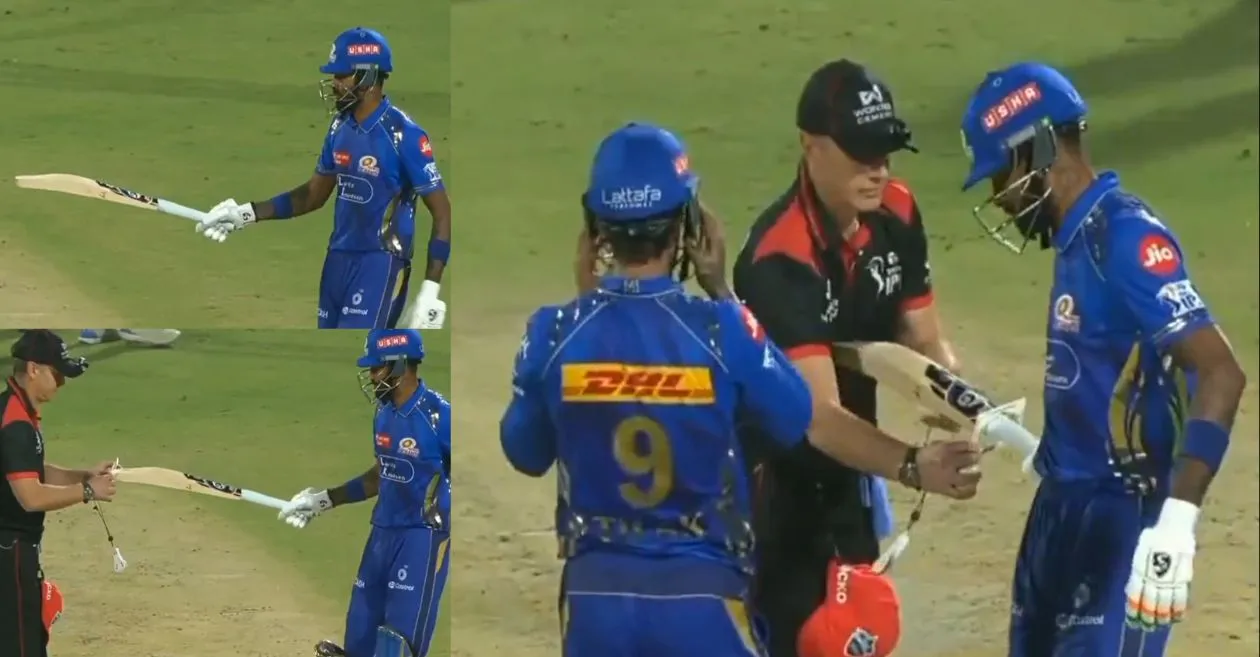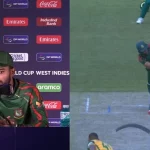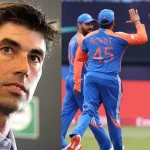The Indian Premier League (IPL) is known for its high-octane cricket, passionate fans, and thrilling finishes. But IPL 2025 took the drama up a notch with an unexpected twist during the clash between Delhi Capitals (DC) and Mumbai Indians (MI). In a move that took fans, players, and commentators by surprise, MI captain Hardik Pandya’s bat came under scrutiny in an unprecedented incident that sparked widespread discussions across social media and cricketing circles. Mid-match, the umpire halted play briefly to measure Pandya’s bat using a specialized gauge, prompting widespread curiosity about what exactly was happening.
This unexpected moment not only highlighted the increasing focus on player equipment but also brought attention to the updated IPL 2025 playing conditions. What was initially a seemingly small incident soon became the focal point of conversation, as fans questioned whether bats were becoming oversized and contributing too much to the increasing scores in T20 cricket.
Why Was Hardik Pandya’s Bat Measured by the Umpire?
The moment when the umpire halted play to inspect Hardik Pandya’s bat wasn’t just a random check—it was in line with a new rule introduced in IPL 2025 aimed at ensuring fairness in the game. The rule states that a bat used in the tournament cannot exceed 4.25 inches (10.8 cm) in width, and it must pass through a special bat gauge at all points, without any obstruction. This rule was designed to counter the growing concerns over oversized bats, which have been a topic of debate in recent years, particularly as T20 cricket has seen record-breaking scores and increasing dominance of the bat over the ball.
The crackdown on oversized bats was part of a broader push by the IPL governing body to maintain fairness in the competition, where batters are regularly scoring 200+ runs. While skill and technique remain critical, the tools of the trade, like bats, have been identified as potentially tipping the balance. With several players using bats with huge edges, there were concerns that these oversized bats might provide an unfair advantage, making it easier to hit big shots, even on mishits.
The timing of this incident was significant, as it followed a similar bat inspection earlier in the day during the Royal Rajasthan (RR) vs. Royal Challengers Bangalore (RCB) match, where bats belonging to Phil Salt and Shimron Hetmyer were measured. Both players were forced to switch their bats after failing the test. This left many wondering if the introduction of this rule was a response to the increasing number of oversized bats being used in T20 cricket, especially when the scores have consistently been on the rise.
So, why exactly was Hardik Pandya’s bat put under the spotlight? The reason is simple: officials wanted to ensure that no player was using equipment that was outside the legal specifications, especially in a high-pressure tournament like the IPL, where small advantages can have a massive impact. As the popularity of T20 cricket continues to soar, the scrutiny around equipment used in the game is expected to increase, and Pandya’s bat inspection was merely a glimpse into the future of stringent checks that will be part and parcel of the modern game.
The IPL 2025 Bat Inspection Rule: Fairness at the Forefront
The decision to implement bat inspections in IPL 2025 comes at a time when T20 cricket is experiencing an explosion in power hitting. With modern bats featuring massive edges and lightweight construction, hitting sixes has become more common, even on mis-hits. The IPL, known for its high-scoring games, has seen a surge in 200+ totals, and with it, the debate over whether these inflated scores are a result of overpowered bats rather than just batters’ skills.
The rule introduced in IPL 2025 mandates that a bat cannot exceed the 4.25-inch width limit and must pass smoothly through a special gauge, which is essentially a standard measurement tool used to ensure that the bat conforms to the prescribed dimensions. This measure is aimed at curbing the use of bats with unnaturally large edges, which have been accused of providing batters with an unfair advantage. By introducing this regulation, the IPL governing body aims to ensure that equipment does not overshadow a player’s skill, keeping the balance between bat and ball in check.
Moreover, the bat inspections serve as a precautionary step in maintaining the integrity of the game. As the IPL becomes a larger commercial spectacle, the need for transparency and fairness grows, and equipment checks are becoming as vital as player fitness and skill. The inclusion of such checks will ensure that the focus remains on the talent of the players rather than any potential loopholes that can be exploited through equipment manipulation.
For Hardik Pandya, who is known for his powerful hitting, the bat inspection was an interesting moment of the match. While it was a temporary disruption, it highlighted the IPL’s commitment to fairness and the evolving nature of T20 cricket. In the end, Pandya’s bat passed the test without any issue, but the message was loud and clear: the IPL is serious about maintaining a level playing field for all players, regardless of their reputation or skill.
A Brief Moment, But Widespread Reactions
Though the bat-checking incident involving Pandya lasted only for a few moments, it sparked a cascade of reactions from fans and commentators alike. While some were baffled by the suddenness of the intervention, others appreciated the move, acknowledging the importance of ensuring fairness in such a high-profile tournament. It was clear that the incident had caught the imagination of cricket fans, and discussions around bat specifications began to dominate the social media space.
In particular, fans were curious about whether this scrutiny would extend to other players, especially those known for their big-hitting abilities. Some speculated that players like Chris Gayle, Andre Russell, and other power-hitters would face similar scrutiny, with their large bats becoming a topic of debate. The reaction to the incident reflected the growing consciousness among fans and experts alike about the importance of maintaining the balance between bat and ball in the fast-paced world of T20 cricket.
Interestingly, Pandya’s own performance in the match took a backseat to the bat controversy. The MI skipper could only manage a modest 2 runs from 4 balls, but it was his bat that stole the limelight. This highlighted how the IPL, despite being known for its exhilarating cricket, is evolving into a platform where even the smallest of incidents can snowball into major talking points.
MI’s Narrow Victory: A Match Full of Drama
While the bat inspection grabbed most of the headlines, the match itself was no less thrilling. In a nail-biting contest, Mumbai Indians edged past Delhi Capitals by just 12 runs, with MI posting a total of 205/5. While Pandya’s bat incident had created an atmosphere of intrigue, it was Karun Nair’s explosive innings for DC that kept the crowd on their toes.
Nair, returning to the IPL after a long hiatus, made a significant impact with his bat, scoring 89 runs from 40 balls. His aggressive strokeplay kept DC in the chase, but despite his best efforts, they fell short of the target. The turning point in the game came with Karn Sharma’s brilliant performance with the ball, where he picked up crucial wickets, including that of Nair. Sharma’s 3-wicket haul played a decisive role in restricting DC to 193, sealing a thrilling victory for MI.
While the bat-checking moment may have overshadowed Pandya’s underwhelming performance, the match was still a rollercoaster of emotions, filled with moments of brilliance and some tense exchanges. DC’s fightback, spearheaded by Nair, was admirable, but MI’s experience and tactical bowling were too much for them to overcome in the final overs.
The Future of Bat Inspections in IPL
Hardik Pandya’s bat inspection in IPL 2025 has set a precedent for what could become a regular feature in future editions of the tournament. With the game evolving rapidly and power-hitting reaching new heights, ensuring fairness in equipment will be crucial for maintaining the integrity of the sport. This incident serves as a reminder that the IPL, while celebrating the power and skill of its players, is also keeping a keen eye on the tools they use.
As the IPL continues to grow in stature and popularity, players, teams, and fans will have to adjust to these evolving regulations. Whether or not the bat inspections will become a regular occurrence remains to be seen, but the message is clear: in the fast-paced world of T20 cricket, fairness and integrity will always remain at the forefront.
For now, the IPL 2025 clash between DC and MI will be remembered not just for the thrilling cricket but for the moment when Hardik Pandya’s bat became the subject of intense scrutiny—marking a new chapter in the ongoing evolution of cricket’s most exciting format.
Please check for information on the best betting sites in India – https://selectory.org/best-betting-sites/















